Construction of the Insight Race Car
In the beginning ...
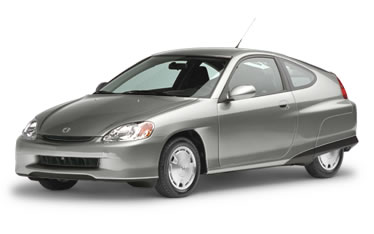
Little is known about the early life of
2000 Honda
Insight #358. What is known is that it was a 5 speed manual
transmission model in classic Silverstone Metallic. It probably lived
somewhere
near Plainfield, NJ. Sometime in 2002 it met with an immovable object.
Its left front side was crushed destroying the headlight, front bumper
and fenders, breaking the windshield, bending the
drivers side door slightly, and deploying the airbags. #358 was
pronounced totaled and sent to the salvage yard. It was saved from
aluminum recycling by Inline Pro later in 2002. The car then sat in
Inline's
shop waiting to begin its new life.
Highland Racing took control of the car in September 2003.
Chassis
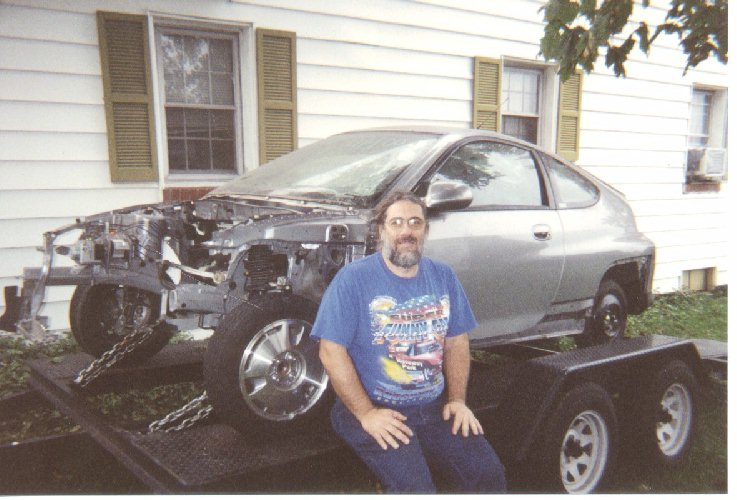
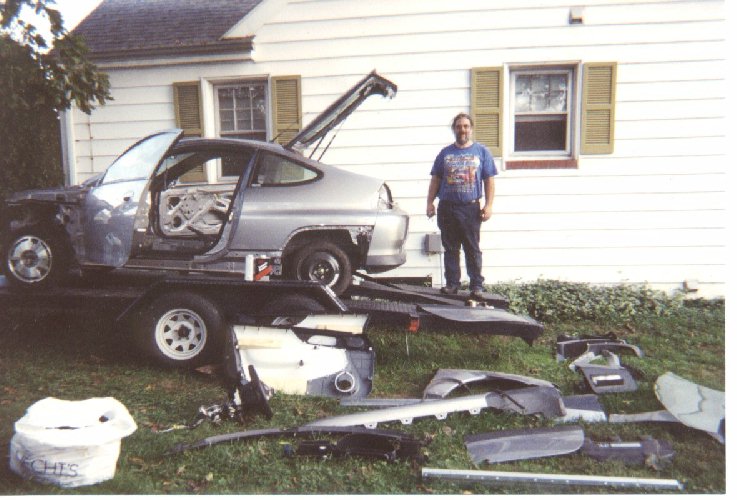 The car was first
striped of all parts down to the frame. All that
was left was the front suspension, steering mechanism, rear suspension,
windows, and doors/hatch. Everything else (interior panels, wiring,
brake lines, etc.) was removed. The suspension was left in for ease of
transport and the windows so that Lexan molds could be made.
The car was first
striped of all parts down to the frame. All that
was left was the front suspension, steering mechanism, rear suspension,
windows, and doors/hatch. Everything else (interior panels, wiring,
brake lines, etc.) was removed. The suspension was left in for ease of
transport and the windows so that Lexan molds could be made.
Then it was off to Ken Keir Race cars for some serious work.
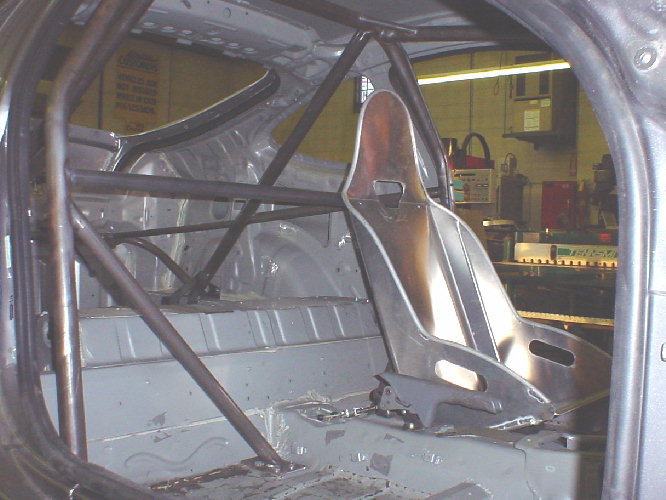
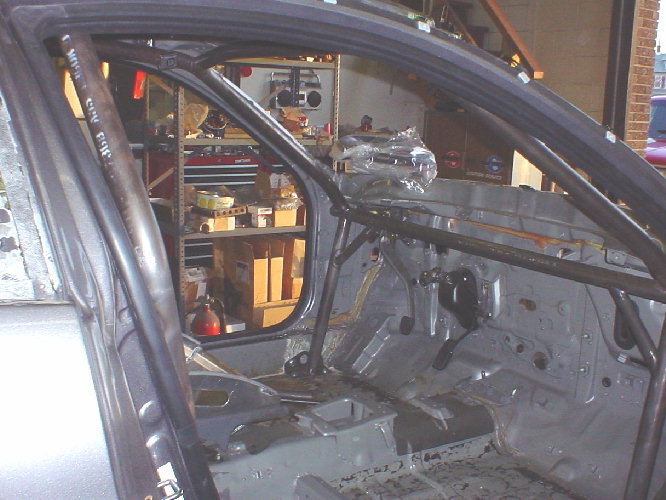 A full 6 point roll
cage was constructed out of
chromoly tubing. The all aluminum chassis of the Insight meant that
each point had to be bolted to the floor using plates per NHRA safety
regulations. As part of this, a Jazz
race seat was installed as well as a steering column and window net
supports.
A full 6 point roll
cage was constructed out of
chromoly tubing. The all aluminum chassis of the Insight meant that
each point had to be bolted to the floor using plates per NHRA safety
regulations. As part of this, a Jazz
race seat was installed as well as a steering column and window net
supports.
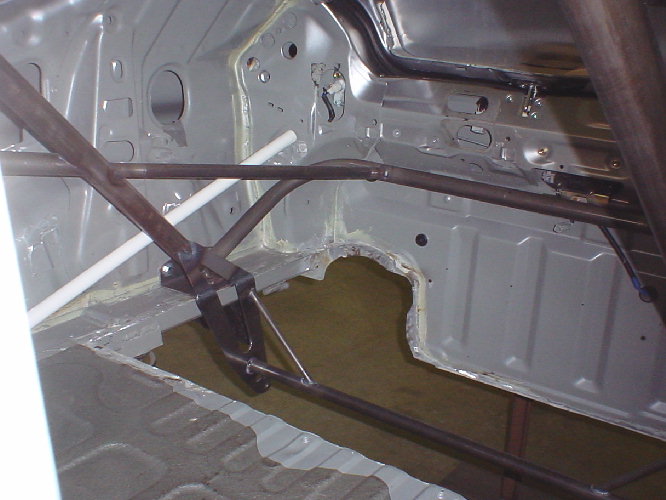
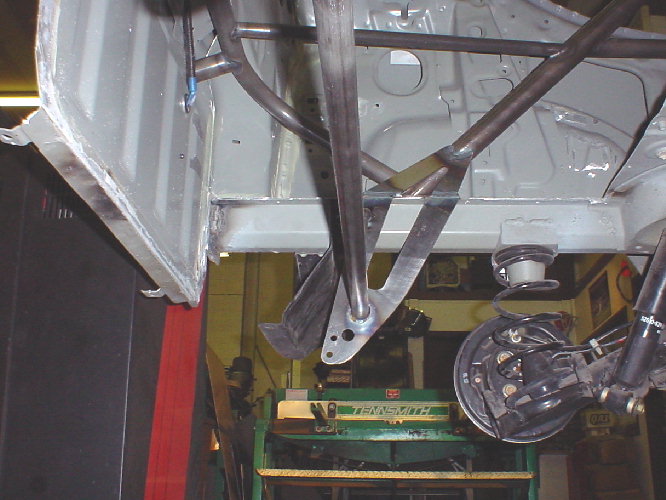
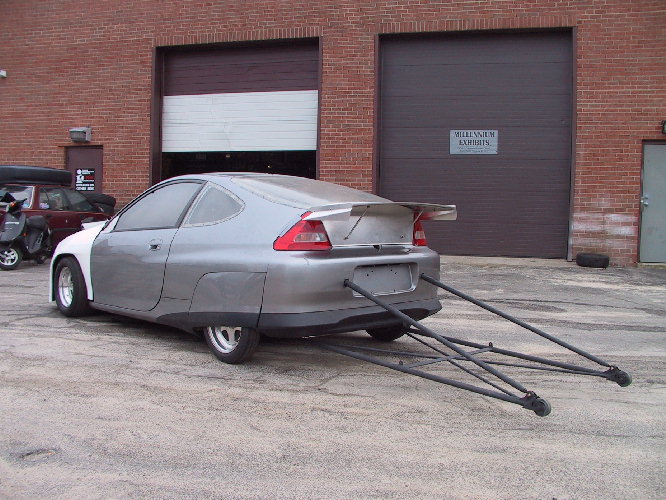
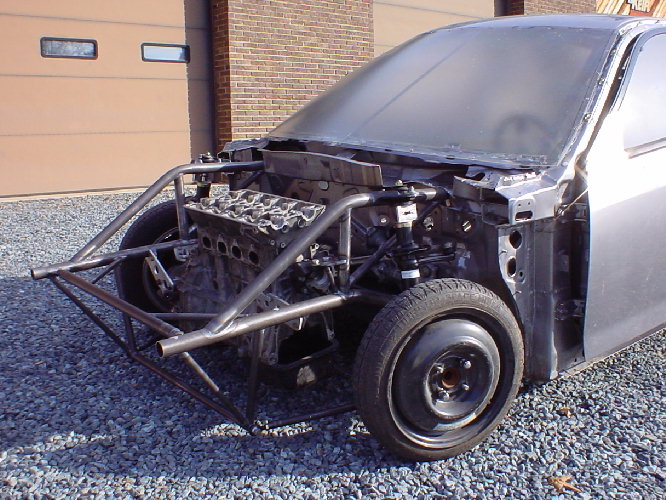
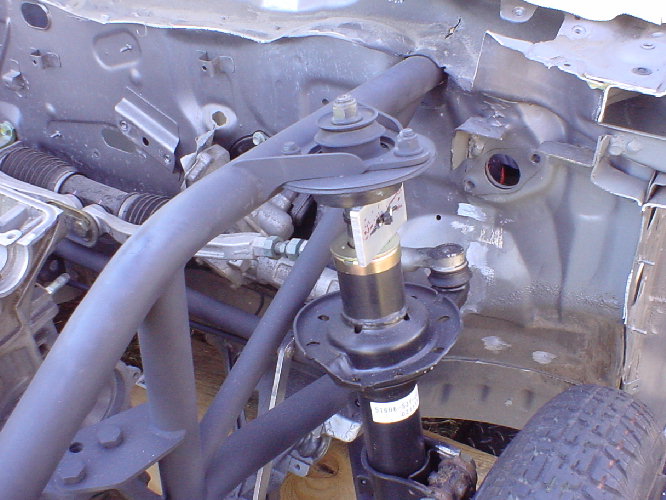
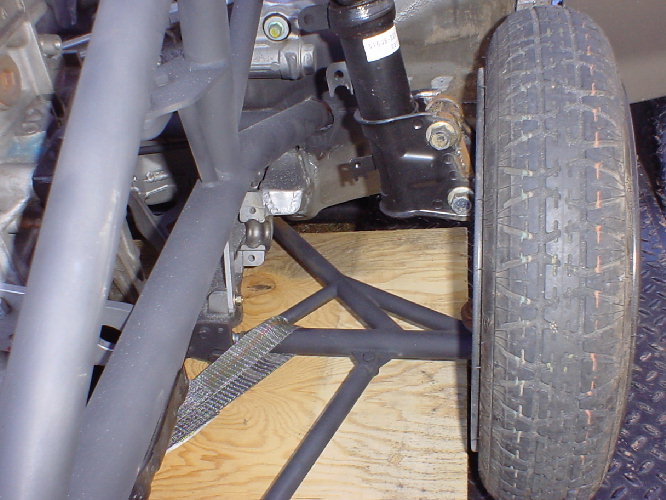
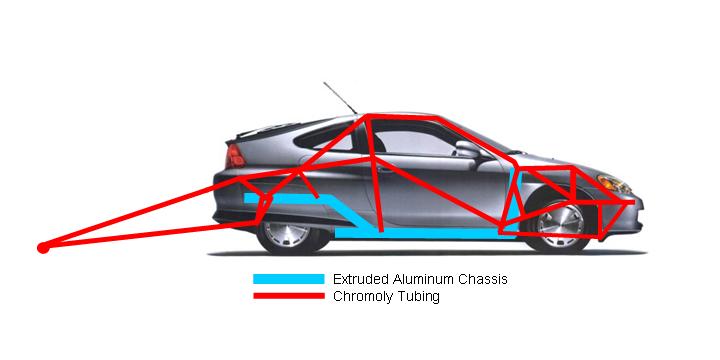
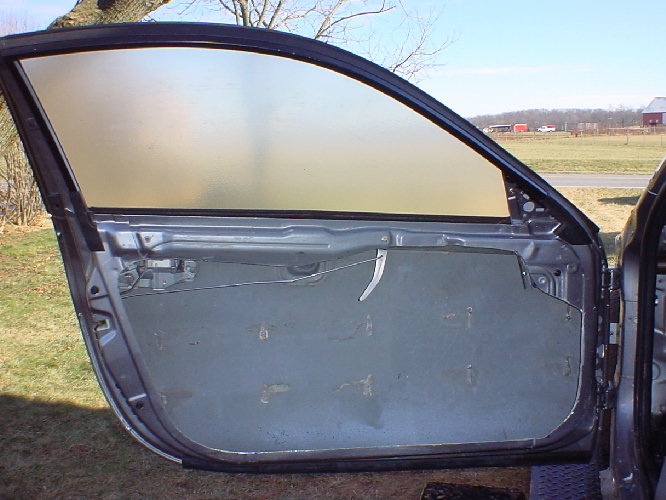
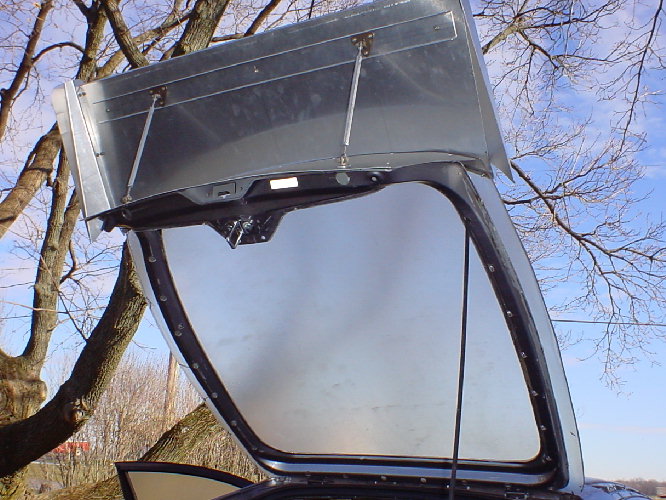
The front bumper and fenders were replaced with a one piece carbon
fiber front end to improve
aerodynamics, reduce weight and simplify maintenance. All other
exterior body
panels are stock Insight aluminum and plastic components
including the aerodynamic rear fender skirts.
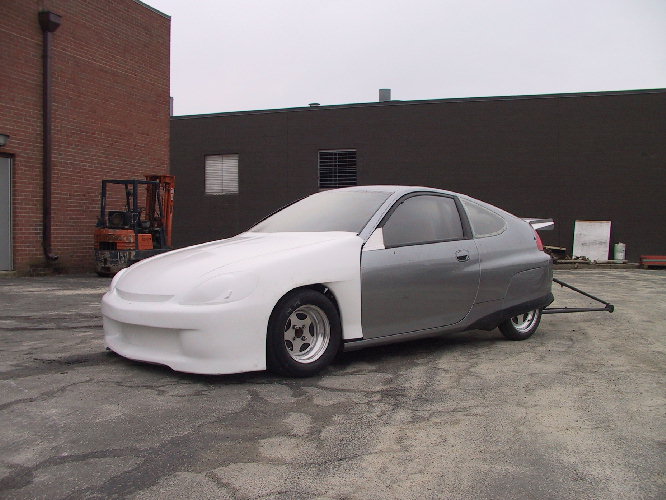
A flat, NHRA spec Pro Stock style spoiler was built and attached to the rear hatch.
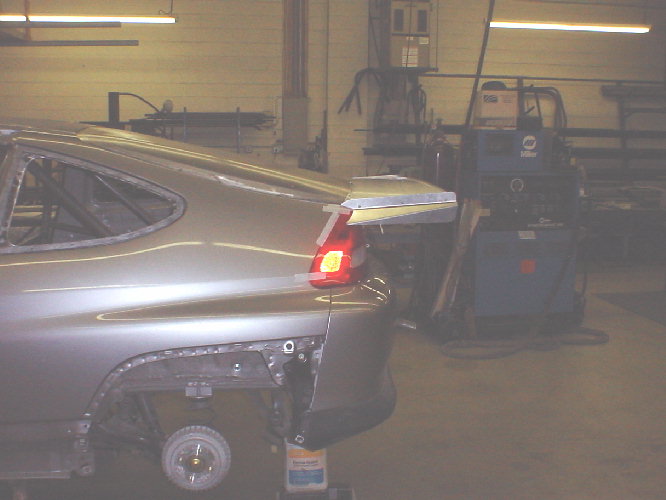
The interior was striped of all accessories, electrical lines, sound deadening and any flanges and attachment points that were not needed. The base interior was left in the original Sliverstone Metallic color with large holes covered in aluminum sheet. The silver background is accented by the lightweight carbon fiber sandwich panels on the doors and sides along with a custom carbon fiber dashboard. The role cage and all tubing was painted in hammered black to further complement the aluminum and carbon fiber interior scheme.
Chassis

 The car was first
striped of all parts down to the frame. All that
was left was the front suspension, steering mechanism, rear suspension,
windows, and doors/hatch. Everything else (interior panels, wiring,
brake lines, etc.) was removed. The suspension was left in for ease of
transport and the windows so that Lexan molds could be made.
The car was first
striped of all parts down to the frame. All that
was left was the front suspension, steering mechanism, rear suspension,
windows, and doors/hatch. Everything else (interior panels, wiring,
brake lines, etc.) was removed. The suspension was left in for ease of
transport and the windows so that Lexan molds could be made.Then it was off to Ken Keir Race cars for some serious work.

 A full 6 point roll
cage was constructed out of
chromoly tubing. The all aluminum chassis of the Insight meant that
each point had to be bolted to the floor using plates per NHRA safety
regulations. As part of this, a Jazz
race seat was installed as well as a steering column and window net
supports.
A full 6 point roll
cage was constructed out of
chromoly tubing. The all aluminum chassis of the Insight meant that
each point had to be bolted to the floor using plates per NHRA safety
regulations. As part of this, a Jazz
race seat was installed as well as a steering column and window net
supports.
The rear of the roll cage was reinforced
to support the wheelie bars
which attach just below the hatch and under the car. The wheelie bars
are adjustable height and extend approximately 60" from the rear
bumper.



The front frame rails on the Insight are
composed of hexagonal aluminum extrusions with improper geometry and
insufficient strength
for a 300 HP B or K series motor. Similarly, the Insight's MacPherson
strut front suspension utilizes an aluminum spindle and
lower control arms to reduce weight. These will also not withstand the
stress of drag racing. As a result, the entire front end frame was
replaced to provide the proper strength and support.
After the original front frame components of the Insight were removed, a new frame structure was made from chromoly tubing. The tubing extends from the roll cage forward providing mounting for the motor and an anchor for the shock towers. The engine was attached to these using custom fabricated aluminum plates. This allows a B series motor to be attached at all five attachment points for strength and stability. The frame system was intentionally made symmetrical so that it could be modified for a K series motor in the future.
After the original front frame components of the Insight were removed, a new frame structure was made from chromoly tubing. The tubing extends from the roll cage forward providing mounting for the motor and an anchor for the shock towers. The engine was attached to these using custom fabricated aluminum plates. This allows a B series motor to be attached at all five attachment points for strength and stability. The frame system was intentionally made symmetrical so that it could be modified for a K series motor in the future.

To beef up the suspension, the Insight's
aluminum spindles will be
replaced with steel units
from a late model Civic. While still a MacPherson strut suspension
system, the Civic's slight differences in geometry require some custom
modification of the struts. The Insight's aluminum lower control arms
were replaced with chromoly
units fabricated by Ken Keir. These utilize the same mounting points as
the original but with much stronger components. The modified original
struts are retained along with
the steering mechanism (minus the electrical power assist). Further
suspension stability is provided by front mounted traction bars
connected to the frame. The springs
were replaced with harder and shorter springs to get
approximately a 3" drop from stock ride height.


The stock trailing arm rear suspension
was retained largely intact.
The lower bump stop was modified and the springs replaced to allow
approximately 3" lower ride. Shocks were replaced with adjustable
racing shocks.

The resulting frame structure works with
the original aluminum
substructure to
provide safety, light weight and a stiff racing chassis that will
support the
loads of hard launches and high horsepower motors.
Body
The stock glass windows were removed and
replaced with light weight
Lexan. The side windows are reasonably flat and use flat Lexan sheets
mounded to the original window frames. The front and rear windows have
compound curves and had to be custom molded for the proper fit and
aerodynamics. The doors were gutted leaving only the outer skin, the
window frames, door latches and a minimum amount of inner shell for
rigidity. As most parts of the doors are aluminum or plastic, the
striped door with Lexan windows weighs only 22lb each. The rear hatch
was also gutted to provide a frame for mounting the Lexan window. The
complex electro-mechanical rear hatch latch mechanism was replaced with
a simpler system to provide a light weight working hatch.



A flat, NHRA spec Pro Stock style spoiler was built and attached to the rear hatch.

The interior was striped of all accessories, electrical lines, sound deadening and any flanges and attachment points that were not needed. The base interior was left in the original Sliverstone Metallic color with large holes covered in aluminum sheet. The silver background is accented by the lightweight carbon fiber sandwich panels on the doors and sides along with a custom carbon fiber dashboard. The role cage and all tubing was painted in hammered black to further complement the aluminum and carbon fiber interior scheme.